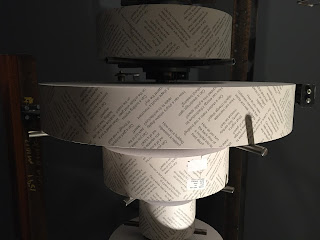Ever since I was 10 years old, space was an intriguing entity, mostly because of its infinite size and at the same time our somewhat little knowledge of it. I grew up dreaming to be an astronaut, as stereotypical as that may be, as I read many books and comics of tales to the moon and space adventure. I even had the typical glow in the dark stars on my ceiling to look at as I fell asleep. We do know how little the Earth is in comparison to the rest of the universe. Carl Sagan says in his A Pale Blue Dot, "our imagined self-importance, the delusion that we have some privileged position in the Universe, are challenged by this point of pale light." In other words, we hold ourselves to be a influential part of the universe, yet we could hold no significance in the larger picture.
Many artist's work have been inspired by the uncertainty and popularity of outer space, one being Robert Rauschenberg, who was invited by NASA to witness the Apollo 11 launch. He was inspired by all things NASA, from buildings to vessels, and you could see it in his work. His 1950's work anticipated the pop art trend, as he took nontraditional mediums and used them in new and original ways.
Movies have been exploring the possibilities and also market, most notably recently. Interstellar and Gravity are too box office hits within the past two years that have explored the potential of space. I particularly enjoyed Interstellar, as astronauts travel through a "wormhole" in search of a new home for society. The movie proved to be popular and controversial, as people disagreed as to what the force to propel Matthew McConaughey through the dimensions. It was a ground breaking film and got people thinking of the many possibilities of space travel.
Sources
Sagan, Carl. "A Pale Blue Dot Quotes." Good Reads. N.p., n.d. Web. 30 May 2015.
"SFMOMA | SFMOMA | Explore Modern Art | Our Collection | Robert Rauschenberg | Space (Tribute 21)." San Francisco Museum of Modern Art. N.p., n.d. Web. 31 May 2015.
Rauschenberg, Robert. Stoned Moon. Digital image. Rauschenberg. Robert Rauschenberg Foundation, n.d. Web. 26 May 2015.
"Interstellar (film)." Wikipedia. Wikimedia Foundation, n.d. Web. 31 May 2015.
"Interstellar Plot Holes." Movie Plot Holes. N.p., n.d. Web. 31 May 2015.
















